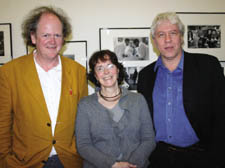|
|
 |
| |

Craig Brown, Sue Limb and John Walsh |
How our top parodists find their greatest apes
PARODY has been a part of English culture for centuries, but is it a serious, even flattering, critique of a person, or simply a base joke at someone else’s expense?
Is the parodist merely a “sedulous ape” who pinches the qualities of their betters to understand how not to be?
Private Eye columnist Craig Brown was joined by writers Sebastian Faulks, Sue Limb and John Walsh to discuss the nature of parody last week, at an English Pen event in the Guardian newsroom in Farringdon.
Instead of trying to define his profession, Mr Brown defended its ambiguity.
“It’s a perfect form for people who are in two minds about things,” he says. “You can toy with the thing without having to possess it.
“Most columnists in Fleet Street have gone bonkers because they are all expected to have about two opinions a week for 40 years, while any sane person has about one in a lifetime.”
He advised would-be parodists not to “try too hard” to rewrite their subjects, saying: “The parodies that don’t work are the ones where people are over-energetic. You only have to change about 10 per cent of what ridiculous writers write.
“Often I’ve done pieces and people have said ‘oh that bit – brilliant, etc,’ and it’s been word-for-word transcript.”
The hardest people to parody are those without style, Mr Brown believes. “When John Major came to power everyone at Private Eye panicked,” he says. As a rule, though, he says, politicians are the easiest.
“The golden months of parody are late September, early October, when the party conferences are going on. You can get these texts of Blair’s or Prescott’s speeches and they are virtually imbecilic.”
An excerpt from his version of Blair’s “Forces of Conservatism” speech reads: “Let’s look at the forces of change. Technological change, social change, loose change, change of heart, change gear, change clothes, change here for the District and Circle line.
“The question is: how are we to meet this change? The answer is people. The future is people. For every person, a future. In future, every person a people.”
Mr Brown describes parody as “a dance with your victim” in which you must use the same movements and turns of phrase.
He adds ruefully: “You can’t predict who will like it. You can spit all this venom at a person and they love it. It’s the solicitors’ letters that keep you going.”
|
 |
|
| |
|
 |
|

